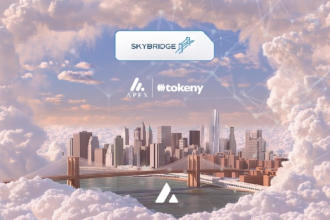Layer 1 (L1) blockchain is the fundamental network of the blockchain ecosystem. It operates independently without relying on other chains for validation or execution, handling everything from transaction processing to consensus to storing data on its own ledger.
The layer 1 blockchain, often referred to as the mainnet or payment layer, forms the ground floor on which all other blockchain layers are built, including sidechains and layer 2.
Layer 1 is independent when Layer 2 extends performance over an existing network. They define their own rules, run their own validators, and issue their own native tokens. Bitcoin, Ethereum, Solana, Cardano, and Avalanche all fit this description.
In this article, we’ll look at the history and functionality of Web3’s foundational layer.
Inside Layer 1: How to Build Layer 1
All L1 blockchains include several core components that make them both functional and secure.
- Network node: Thousands of independent computers maintain identical copies of the blockchain and broadcast data to each other. The decentralized nature prevents censorship and single points of failure.
- Consensus layer: A rulebook for consensus. This determines how participants decide which transactions are valid and how blocks are added to the chain.
- Execution layer: On top of programmable blockchains like Ethereum and Solana, this layer executes smart contracts, or self-executing code that powers decentralized apps and automated transactions.
- Native cryptocurrency: Each L1 has its own coin that pays transaction fees, rewards validators, and supports on-chain governance. BTC secures Bitcoin, ETH powers Ethereum, and ADA powers Cardano.
How Layer 1 processes transactions
The flows are almost the same between different networks.
- verification: Transactions are checked to ensure they meet protocol rules and have proper signatures and balances.
- Block formation: Validated transactions are bundled into candidate blocks.
- consensus: The nodes agree on which block to add next using an algorithm chosen by the network.
- Finality: Once confirmed, the block becomes immutable. Balance and contract data are updated via the network.
This cycle repeats continuously, thousands of times a day, without any central oversight.
Consensus mechanism: the heart of blockchain
The consensus mechanism defines how a blockchain reaches consensus, shaping its speed, security, and energy profile. Various consensus mechanisms exist, but the main ones are:
- proof of work (Prisoner of War)– Introduced by Bitcoin, PoW miners solve cryptographic puzzles through computation. Although very secure, it consumes a lot of energy and is limited to approximately 7 transactions per second (TPS).
- proof of stake (PoS)– Validators lock tokens as collateral to earn the right to validate blocks. Replace energy use with economic incentives.
- Delegated Proof of Stake (DPoS)–This model, used by Binance Smart Chain and others, relies on a small, chosen set of validators to improve efficiency, trading off speed and decentralization.
- proof of history (PoH)–Solana’s proprietary system timestamps transactions before consensus, enabling thousands of TPS and sub-second block times.
Main Layer 1 Blockchain
Bitcoin (BTC) – Proof of Work: The first and most secure blockchain. It uses energy-intensive mining to process around 7 TPS and emphasizes decentralization and immutability over speed.
Ethereum (Ethereum) – Proof of Stake: The largest programmable blockchain supporting smart contracts, NFTs, and DeFi. After the 2022 merge, we reduced energy usage by over 99% while laying the foundation for scalability with rollups and future sharding.
Solana (sol) – Proof of History + PoS: Known for its high throughput and low fees, Solana timestamps transactions before reaching consensus, achieving sub-second block times.
Cardano (ADA) – Ouroboros Proof of Stake: A research-driven blockchain that emphasizes formal verification and a layered architecture to separate settlement and computation.
avalanche(Abax) – Avalanche Consensus: Uses stochastic sampling to quickly reach consensus. It provides sub-second finality and supports customizable subnets for app-specific chains.
Binance Smart Chain (BNB) – Delegated Proof of Stake: Operated by a limited set of validators, BSC trades decentralization for performance, offering fast and low-cost transactions that are compatible with Ethereum’s tools.
Timeline: Key Layer 1 Milestones
- January 2009: Bitcoin launches as the first fully functional blockchain to prove decentralized consensus through proof of work.
- July 2015: Ethereum goes live, introducing programmable, Turing-complete smart contracts to the blockchain ecosystem.
- September 2017: Cardano launches Byron mainnet, formalizes proof of stake using the Ouroboros protocol and establishes a layered architecture.
- September 2020: Avalanche launches mainnet and introduces a fast consensus mechanism and subnet framework for customizable chains.
- September 2022: Ethereum completes the merge, moving from Proof of Work to Proof of Stake, reducing energy consumption by over 99%.
- October 2023: Celestia is being launched as the first modular blockchain focused on data availability and consensus separation.
- August 2025: Circle announced Arc, a layer 1 focused on stablecoins, with a public testnet launching in October and mainnet expected in 2026.
Each blockchain aims to address the same fundamental challenge: the blockchain trilemma.
Blockchain trilemma
Ethereum co-founder Vitalik Buterin coined the term “blockchain trilemma” in 2017 to describe the challenge of blockchain’s inability to simultaneously maximize decentralization, scalability, and security, forcing trade-offs between these three.
- safety – Protection against manipulation and attacks.
- Scalability – Ability to handle large volumes efficiently.
- decentralization – Distribution of control across many independent nodes.
Layer 1 scaling
Developers are continually looking for ways to increase blockchain throughput without compromising decentralization, a direct response to the blockchain trilemma.
- Sharding: This technique divides the network into smaller parts (shards) and processes data in parallel to reduce node workload and increase capacity. Ethereum originally planned for 64 shards, but by late 2025 they had shifted their focus to protodunk sharding and dank sharding. The upgrade was centered around data availability for layer 2 rollups rather than full on-chain execution. Proto danksharding (EIP-4844) introduces data blobs to improve storage efficiency, but full danksharding is still in development.
- Consensus optimization: Moving from energy-intensive Proof of Work to Proof of Stake, like Ethereum’s 2022 Merge, greatly improves efficiency. Some new networks mix or adapt consensus models to balance speed, cost, and security.
- Block parameters: Larger blocks and shorter spacing improve throughput, but risk centralization. Larger blocks require more bandwidth and storage. Faster blocks introduce synchronization issues and the number of orphaned blocks.
- Protocol upgrade: Bitcoin’s 2017 Segregated Witness (SegWit) is a classic example of direct layer 1 scaling. SegWit frees up block space by separating signature (“witness”) data from transaction data, allowing more transactions per block without increasing size.
real world applications
Layer 1 blockchain has supported DeFi and powered lending, exchanges, and stablecoins through smart contracts. Ethereum and Solana enable NFTs and gaming, bringing digital ownership on-chain. It also improves supply chain transparency, secures digital identities, and enables the tokenization of real-world assets such as property and art.
Why are they still important?
Layer 2 and sidechains can help increase speed, but Layer 1 remains the source of truth. They provide a final resolution, an unchanging history, and a shared trust for all that is built on them.
Blockchain technology has advanced far beyond its inception in 2009, and efforts are not slowing down. In November, the Ethereum Foundation announced its next major step: the Ethereum Interoperability Layer. This allows Ethereum L2s to instantly communicate with other L2s.
As blockchain technology evolves, from energy-intensive mining to modular, quantum-resistant architectures, Layer 1 blockchain continues to define the infrastructure of the decentralized internet.






